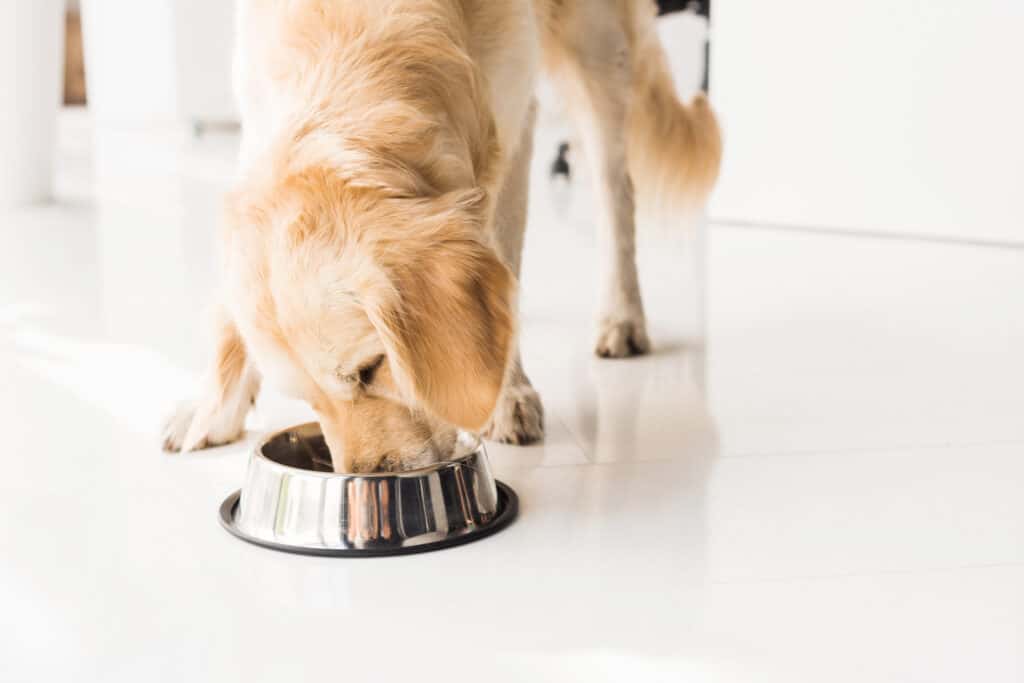Can dogs eat flour? Humans have eaten flour for thousands of years and dogs have lived with us during that time, so it seems likely they can eat this basic food too. Let’s take a closer look to uncover whether it’s safe for dogs to eat flour (and products containing flour), or if flour is toxic for our four-legged friends.
Is It Safe for My Dog to Eat Flour?
Yes, it’s safe for dogs to eat flour if they don’t have a wheat or grain intolerance. Flour is used widely in commercial dog food and treats as a binding agent, so chances are your dog is already eating flour.

Flour is safe for dogs to eat as long as they don’t have a wheat or grain intolerance.
©CrissLari/Shutterstock.com
What is Flour?
Flour is the result of grinding up cereal or grain to make a fine powder. It’s more digestible this way and easier to use in baking.
Whole grain flour is the whole grain ground up including the bran, germ and endosperm whereas refined flour is just the endosperm. If you’re wondering about ‘meal’ as in cornmeal that’s a type of flour too, but it’s less finely ground up.
The word flour actually comes from the word flower or rather fleur which is French for flower and also the finest. Flour is a variant of fleur, so flour got its name because it’s the finest part of the ground-up meal.
Humans have used ground-up grain for thousands of years, dating back at least 6,000 BC and archaeologists have found bread-baking evidence even further back in time to 14,000 BC in northwest Jordan. It’s certainly a food product that we’ve relied on for many years.

Whole grain flour is the whole grain ground up including the bran, germ and endosperm.
©iStock.com/Belyaevskiy
Health Benefits of Flour
There’s a surprising amount of nutrients in flour, but not all flours are created equal. Whole wheat versions have the most benefits because they retain more of the grain, so if you are looking for the healthiest flour choose one that’s whole and not refined.
Here are some of flour’s health benefits and a few of the tasks its nutrients perform:
- Vitamin B1 – helps convert food into energy
- Selenium – makes DNA, metabolizes hormones, and protects against infections
- Folate – supports protein metabolism, healthy DNA, and red blood cell formation
- Riboflavin – an antioxidant that converts food to energy and supports cell functions
- Niacin – supports the nervous system and digestive system
- Iron – creates red blood cells and maintains the immune system
- Manganese – helps form connective tissues and supports blood clotting
- Phosphorus – repairs tissue and cells and helps metabolize other nutrients
So there are plenty of health benefits in flour, but what about the risks?
Risks of Eating Flour
There are very few risks associated with dogs eating flour and, as we’ve already seen, lots of pet food manufacturers include it in their balanced commercial foods, but here are the potential ways flour can be harmful.
Loose flour is a choking hazard
Dogs should never be given a bag of flour to play with or eat because the fine particles can cause choking and even enter their lungs and cause breathing difficulties or infections.
If your dog gets into a flour bag and starts coughing, sneezing, and choking take them straight outside and offer water. Wipe their eyes and nose clear and call a vet for advice if you’re concerned.
Wheat intolerance
Just like humans, dogs can have an intolerance or an allergy to certain foods. Wheat intolerance isn’t uncommon and as a result, dog food manufacturers offer grain-free dog food. We’ll talk about wheat intolerance a bit later.
Potential for bacteria
Raw flour (or dough and batters) can contain bacteria such as E-coli. The Centers for Disease Control and Prevention (CDC) recommended all food containing flour is cooked before it’s eaten.
High Carbs
Flour is low in fat and cholesterol but it is a high-carb food, so too much of it can lead to doggy weight gain. According to the Association for Pet Obesity Prevention 56% of pet dogs in the United States are overweight or obese. Being overweight reduces your dog’s quality of life because it can lead to joint pain, diabetes, and an increased risk of cancer or hypertension.
Can Dogs Eat Whole Wheat Flour?
Yes, dogs can eat whole wheat flour unless they’re intolerant and it’s a better choice because it contains more nutrients and fiber than white, refined, or bleached flours do.
Eating the germ, endosperm, and bran parts of cereal means your dog will get more vitamins and minerals in greater quantities.
Wheat Allergy Symptoms
Dogs can be allergic to wheat just like humans can. A wheat allergy creates symptoms that include stomach aches, diarrhea, itchy skin, and a runny nose. Over time, a dog will go gradually downhill and one of the first signs is usually a poor coat that they are always scratching and chewing on. Vets can diagnose a wheat allergy easily through a blood test or stool test.
If your dog is suffering after eating wheat, he’ll need to avoid wheat flour. Unfortunately, wheat is common in dog food and treats, however, there are lots of retailers offering wheat or grain-free dog food to try out.
Gluten Intolerance
A gluten intolerance is similar but it’s a digestive disorder, not an allergy and a wider range of grains will result in symptoms. Gluten is a protein found in wheat plus barley and rye so each of these grains will cause symptoms.
If you think your dog has a wheat allergy and you cut it out of their diet but they continue to have symptoms it could be they are intolerant to gluten. In this case, you’ll need to cut out rye and barley too.
My Dog Ate a Bag of Flour What Should I Do?
Unless your pooch has an intolerance there’s no need to worry, flour won’t harm them. Just monitor them for a few days in case they’ve inhaled flour particles and it’s caused a blockage or infection. Any concerns and a vet is best placed to advise.

Flour is used widely in commercial dog food and treats as a binding agent, so chances are your dog is already eating flour.
©iStock.com/LightFieldStudios
What Foods are Poisonous to Dogs?
Flour isn’t toxic for dogs and it’s a widely used ingredient in dog food, but there are some foods and drink they should never ingest.
- Garlic – garlic, onions, chives, and shallots are all part of the Allium family that’s dog toxic. Their compounds stick to red blood cells and cause anemia. This applied to raw or cooked alliums, so be vigilant around garlic bread and pizza meal times in case Rover snaffles something.
- Chocolate – this sweet treat is tempting to dogs but the caffeine and the theobromine are stimulants they can’t process. Chocolate can cause organ failure, so it’s really important to keep candy bars, cakes, and biscuits out of reach.
- Grapes – Scientists aren’t sure why grapes are so toxic to dogs, but they think the compounds are indigestible. Grapes (and wine, juices, and raisins) are really toxic and may lead to organ failure.
- Macadamia nuts – these tasty nuts are eaten whole or baked into cookies and cakes but they are highly toxic to dogs. One of the first signs of macadamia nut poisoning is weak back legs because they quickly affect dogs’ muscles and coordination.
- Alcohol – Alcohol contains ethanol which is toxic and results in liver and kidney failure. This includes wines, beer, spirits, cocktails, and alcohol-infused sweets.
- Xylitol – artificial sweeteners are really bad news for dogs. They create a huge drop in blood pressure that can cause hypoglycemia and be fatal. Xylitol is most often found in low-sugar options including Jell-o, juice, and coffee creamer.
Can Dogs Eat Flour – The Bottom Line
Dogs can eat flour if they don’t have an intolerance but it’s not something that needs adding to their diet. Flour is a constituent part of many commercial dog foods and baked treats, so the chances are they are getting enough already. If you make your own dog food, it’s fine to add some flour as a binder. Whole grain versions contain more nutrients, so they are usually the best option.
If you want to vary your dog’s diet, add in some healthy treats like bell peppers or edamame beans or a very occasional puppaccino.
Up Next
- Can Dogs Eat Popcorn? It Depends
- Can Dogs Eat Bread Safely?
- Can Dogs Eat Cornbread?
- Can Dogs Eat Salt, Or Is It Dangerous?
The photo featured at the top of this post is © Masarik/Shutterstock.com
Ready to discover the top 10 cutest dog breeds in the entire world?
How about the fastest dogs, the largest dogs and those that are -- quite frankly -- just the kindest dogs on the planet? Each day, AZ Animals sends out lists just like this to our thousands of email subscribers. And the best part? It's FREE. Join today by entering your email below.
Sources
- Very Well Fit, Available here: https://www.verywellfit.com/flour-nutrition-facts-calories-and-health-benefits-4119166
- Centers for Disease Control and Prevention, Available here: https://www.cdc.gov/ecoli/2019/flour-05-19
- Onlinefirstaid.com, Available here: https://onlinefirstaid.com/7-first-aid-tips-that-could-save-your-dogs-life
Thank you for reading! Have some feedback for us? Contact the AZ Animals editorial team.






